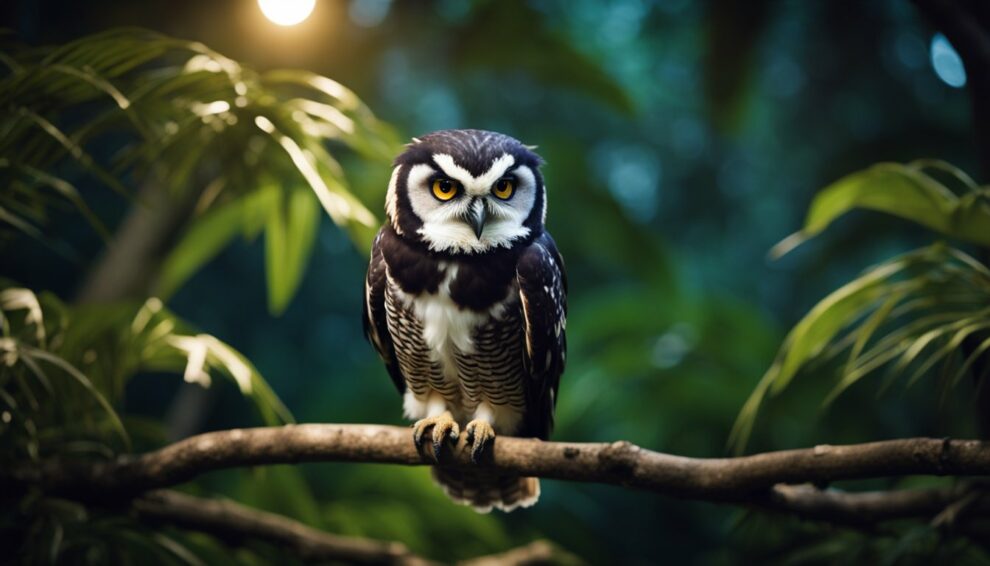Imagine venturing into the dense, verdant canopies of tropical forests after dusk.
Among the symphony of nocturnal sounds, a particular deep hoot echoes, a signature call of the elusive Spectacled Owl, or Pulsatrix perspicillata.
Named for the striking white feathery spectacles surrounding its piercing yellow eyes, this night hunter has an impressive presence.
Its dusky plumage allows it to blend seamlessly into the shadowy foliage, making it a master of stealth in its Neotropical realm.

The Spectacled Owl makes its home in the diverse ecosystems of the Neotropics, from the lowland rainforests to the forest edges in the foothills.
During the day, this owl prefers to roost in the quiet seclusion of shady trees, remaining virtually unnoticed by the world.
As nighttime unfurls its starry cloak, the Spectacled Owl emerges. Have you ever wondered how an owl hunts so precisely in the dark?
The answer lies in their exceptional eyesight and acute hearing, enabling them to pinpoint even the faintest rustle of a leaf — signaling the presence of prey.
With keen senses fine-tuned for nocturnal life, the Spectacled Owl descends upon its unsuspecting quarry with a silent, swift pounce.
Did you know these owls are not just formidable hunters but also caring parents?
Juvenile owls boast a pure white plumage, a stark contrast to the adults’ darker feathers, and rely on their parents for protection and sustenance until they can hunt on their own.
Each aspect of the Spectacled Owl’s life, from their unique appearance to their hunting prowess, paints a vivid picture of adaptation and survival in the tropical forest.
A Peek Into the Owl’s Home

In the lush expanse of the tropical forest, the spectacled owl makes its home, claiming a domain that stretches across continents.
These nocturnal hunters are as much a part of the forest tapestry as the dense canopy overhead.
Diverse Habitats from Mexico to Argentina
The spectacled owl isn’t picky when it comes to its residence; it thrives across a remarkable range of tropical habitats.
From the rainforests of Mexico through the verdant stretches of Central and South America, these owls find comfort in the diverse ecological offerings.
Even within the dynamic ecosystems of Brazil and Argentina, spectacled owls create their havens.
Their homes consist of a rich mosaic of rainforests and dry forests, each providing a unique backdrop for their lives.
The owls have also adapted to life in woodlands and have sometimes been spotted in plantations, hinting at their adaptable nature.
The Forest Edge: A Spectacled Owl’s Playground
Emerging at dusk, spectacled owls frequent the forest edge, a habitat bustling with potential prey and rich with foliage.
It’s where the forest meets more open spaces, creating a mixed environment that caters to the owl’s hunting and roosting needs.
The forest edge offers an ample view of the night’s sky, aiding these silent predators in their aerial pursuits.
They often roost during the day in shady spots, camouflaged by the forest’s natural palette, and yet, despite their discretion, their presence is betrayed by their distinctive calls echoing through the night air.
In this section of the tropical forest, a game of hide and seek unfolds each night.
Can you imagine being a small creature, foraging under the cover of night?
Now think of the spectacled owl’s piercing gaze from above, nearly invisible against the dark sky and dense treetops.
It truly is a dynamic home where survival hangs in the poised balance of predator and prey.
Night Hunter’s Toolbox

The spectacled owl, a master of the night, employs an impressive array of skills and adaptations to secure its meals after dark.
Let’s discover the unique features that make this bird such an effective nocturnal predator.
Superb Sight: The Power of Owl Eyes
Imagine being able to see in near darkness as if it were day. That’s the power of the spectacled owl’s eyes.
Their large, forward-facing eyes allow them to focus precisely on potential prey.
Unlike humans, the eyes of this owl are not spherical; instead, they’re shaped more like tubes, offering a greater visual field and depth perception.
The retina is also densely packed with rod cells, which are incredibly sensitive to light, giving the owl its superb night vision.
This biological night-vision goggles capably guide them in hunting in the dimly lit tropical forests.
Silent Wingbeats: The Art of Stealth
Can you imagine flying without making a sound? It seems like a magic trick, doesn’t it?
Well, for the spectacled owl, silent flight comes naturally.
Their feathers are specially designed for stealth.
The leading edge of their wings has a soft, comb-like structure that breaks up the air turbulence into smaller currents, which reduces sound.
Likewise, the rest of the wing’s feathers are soft and fluffy, absorbing the noise of flight.
This quiet flight is crucial for sneaking up on unsuspecting prey like insects, frogs, crabs, small mammals, and even other birds of prey.
The Owl’s Diverse Menu
Have you ever been curious about an owl’s diet? It’s a smorgasbord out in the wild! The spectacled owl isn’t picky about food.
From the canopy to the forest floor, they’ll snap up various foods.
Their diet includes insects that buzz through the night, frogs that croak after the rain, crabs scuttling across the soil, and small mammals like bats that fly through the moonlit sky.
These powerful predators also hunt other birds, making their menu quite diverse.
With such a varied diet, the spectacled owl plays a crucial role in the ecosystem’s balance, controlling the populations of its prey.
Life Cycle of the Moonlight Predator

The journey of the Spectacled Owl from a hatchling to a guardian of the night skies is a wondrous transformation.
Witnessing these owls mature is like watching the moon traverse the night sky—each phase reveals new beauty and mysteries.
From Egg to Fledgling: Growing Up Owl
Spectacled Owls start their lives as tiny eggs, carefully incubated by the mother for about 36 days.
Nests, which are often found in tree cavities, become nurseries for the chicks.
Once they hatch, these downy-white juveniles rely completely on their parents.
These young owls, marked by a stark contrast from their parents with their snow-white plumage apart from their dark facial masks, grow rapidly.
By six to eight weeks, they start to resemble adults, with brownish-black feathers beginning to appear.
Fledging is an exciting time; typically, around two to three months after hatching, they begin to venture from their nests on shaky wings.
Despite leaving the nest, juvenile owls often stay close by, receiving food and further care from their parents for several months.
Vocalizations and Mating Calls
Communication amongst Spectacled Owls is key, especially during the breeding season.
Their vocal repertoire includes a variety of hoots, whistles, and screeches.
Males court females with a series of deep, resonant hoots—like the strumming of a bass in the moonlit concert of the forest.
They resonate through the dense foliage, signaling strength and presence.
These mating calls not only attract potential mates but also play a role in establishing and defending territory.
As pairs bond, their duets can be heard echoing through the forest, ensuring the cycle of life continues for these enchanting night hunters.
Conservation: Ensuring Owls Thrive
The future of spectacled owls hinges on effective conservation strategies and a deeper appreciation of their role in folklore and culture.
Discover how these efforts and understanding can lead to a brighter future for these winged wonders.
Concerns and Conservation Efforts
Spectacled owls, dazzling night hunters of the tropical forest, face threats from deforestation and habitat loss.
While the International Union for Conservation of Nature (IUCN) currently lists them as “Least Concern,” ongoing environmental pressures could change that.
Vast stretches of their home are disappearing, making it hard for the owls to find the space they need to live and hunt.
Thankfully, conservationists are taking action, setting aside protected areas and advocating for sustainable forestry practices.
The Spectacled Owl in Folklore and Culture
Generating awareness about the spectacled owl isn’t just about science; it’s also about storytelling.
These birds hold a special place in myths and legends, serving as symbols of wisdom and mystery.
By sharing these tales, educators can spark curiosity and foster a cultural appreciation that supports their conservation.
When people see the spectacled owl as part of their heritage, they’re more likely to stand up for its survival.
How You Can Help Protect Our Feathered Friends
How does one become a champion for these majestic birds? It starts with education and awareness.
Learning about the spectacled owl’s habitat and the dangers it faces is the first step.
Sharing knowledge with friends and family can spread the conservation message even further.
And when people support organizations that fight for wildlife preservation, they’re contributing to a world where the spectacled owl, and many other species, can thrive for generations to come.
Frequently Asked Questions

Curiosity blooms at night when the spectacled owl emerges.
Let’s explore the quirks and quintessences of their world through some of the most common queries.
What sorts of foods do spectacled owls prefer to munch on in their habitat?
In the shadowy realms of the tropical forest, spectacled owls are known for their carnivorous diet.
They feast on a variety of critters, from small mammals like mice and bats to insects, birds, and even crabs.
Their meals reflect the rich biodiversity of their lush homes.
Can you describe the hunting techniques a spectacled owl uses in the dark of night?
When the sun sets, the spectacled owl takes flight silently. Its exceptional vision and hearing coordinate to detect the faintest rustles.
Once prey is within sight, the owl swoops down with precision, snatching its meal in an instant before disappearing again into the veil of night.
What are the nifty adaptations that help spectacled owls thrive in the tropical forest?
Spectacled owls sport a plumage that melds into the shadows, camouflaging them perfectly against the dark forest backdrop.
Their feather structure allows near-silent flight, ensuring prey rarely hears them approach.
Plus, their forward-facing eyes give them remarkable depth perception for pinpointing targets in dim light.
How big does a spectacled owl get, and what does this size mean for its lifestyle?
These nocturnal birds range in size, with bodies spanning up to 52 centimeters and boasting a wingspan that can reach a generous width.
This size facilitates a dominant presence, allowing them to claim a vast territory and deter smaller competitors with ease.
Why do spectacled owls have ‘spectacles,’ and how does this feature benefit them?
The distinct white feathers that frame their eyes and give the spectacled owl its name serve an intriguing purpose.
They reflect moonlight, improving their already excellent night vision, and also add a degree of intimidation to their appearance, warding off potential threats.
Who could be the predator of such a skilled predator as the spectacled owl in their ecosystem?
Despite being formidable hunters, spectacled owls can fall prey themselves.
Large birds of prey, like harpy eagles, are often at the top of the food chain and can pose a threat to them, especially for the unsuspecting or younger owls still perfecting their stealthy skills.









